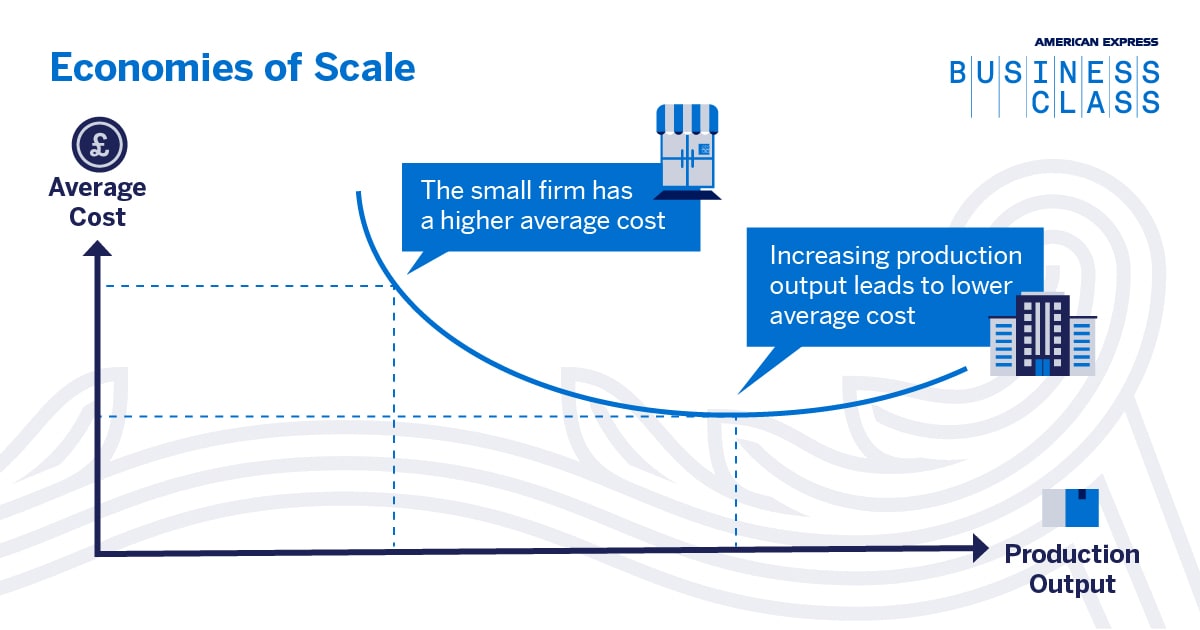The benefits of economies of scale are clear. They can provide businesses with a greater profit margin to accelerate growth, lower average costs and increased efficiency.
However, rushing to scale too quickly can cause even the most promising and innovative businesses to fail. As Aimée López, founder of retail marketing agency Copy Unleashed, puts it: “Once you’re on the hamster wheel, it’s hard to get off.”
What are economies of scale in business?
The economies of scale "hamster wheel" is attractive to many businesses because it allows costs to be spread over a larger amount of goods, ultimately maximising profits. Achieving economies of scale by increasing production typically comes through the greater purchasing power that this gives you with suppliers. However, it can also be achieved by making production more efficient, through means such as investing in new equipment or training employees to become more productive.

Internal vs external economies of scale
Internal economies of scale refer to the cost advantages that arise within a business as a result of its own expansion and increased production levels. This can include:
Purchasing power: The greater quantity of goods a company purchases from a supplier can result in discounts or bulk offers. This reduces the overall cost per unit.
Technical improvements: Bigger and better machinery, tools and equipment help to reduce the overall labour burden and improve production efficiency, reducing overall cost per unit.
Additional training or hiring specialists: Training an employee to have more than one function, or hiring a specialist to increase efficiency, can help to reduce cost per unit.
"Internal economies of scale will be specific to the company and its efforts to increase efficiency and reduce cost. This can be seen through employee tasks and specialisms, what technology is required internally to assist in production, and efficiency or even the use of marketing and advertising to appeal to a wider consumer audience," says Heather Delaney, Managing Director and Founder of Gallium Ventures.
External economies of scale, on the other hand, refer to industry-wide factors that positively impact an entire industry. Examples can include geographical infrastructure projects, shared knowledge within a sector or a skilled labour pool.
External economies of scale may also arise from government actions like tax changes or new business legislation.
Examples of economies of scale
“Fast fashion is a simple example of economies of scale,” says López. Take a large fashion brand that can buy materials like denim, thread, and zippers in bulk, which helps them get better deals from suppliers. They also have more access to cash and a better ability to manage their cash flows. This makes it easier for them to handle changes in material prices and customer demand.
Effects on production costs
“Economies of scale can positively affect product costs as you can create better relationships and negotiate better rates with your manufacturers and suppliers because you are ordering in bulk”, says López.
By increasing volume, you’re splitting the cost of production over more units. By spreading the cost more widely over your units, you can make your products at a lower cost, allowing you to offer lower costs to your customers, and retain more profit in your business.
Managing cash flow while attempting to expand your business isn't easy. With an American Express® Business Gold Card, you have up to 54 days to clear your balance, which may provide greater flexibility to manage your cash flow with your suppliers¹.
Marginal cost and economies of scale
Knowing when to make the jump to economies of scale is a delicate balance. First, make sure you know your marginal cost, which is the change in total production cost that comes from making another unit. When the marginal cost of producing one additional unit is lower than your current price-per-unit (PPU), it could be time to scale.
How to achieve economies of scale
If achieving economies of scale is the right strategy for your business, work strategically and methodically towards success. Here are some key steps you can take towards this goal:
Tap into your network
Delaney recommends collaborating with your peers: “Find like-minded businesses who can band together and either share staffing resources — say, a fractional CMO or CFO — or help negotiate lower costs for bulk purchases”.
Nurture your suppliers
“Manufacturers are very busy folks — some have been in the game for generations”, says López. Ask their opinion on your strategy and learn from their experiences. Present your suppliers with a succinct proposal that contains hard numbers: how much you intend to order, timelines and how they could benefit.
Create realistic forecasts
Draw up a strategic action plan that is broken up into monthly, quarterly and yearly forecasts. Include cash flow projections, allowing you to have a clear and objective roadmap. Use this to support investments in machinery or training to boost efficiency and output levels.
Listen to your customers
Stay attuned to customer feedback and demand for your products. Work with marketing and sales teams to find out what's driving demand. For example, could a price change increase sales and get you closer to economies of scale?
What are diseconomies of scale?
Diseconomies of scale occur when the cost-per-unit price increases, leading to profit reduction with each unit of output. Things like a dwindling workforce, increased costs of raw materials and changes in customer behaviour can all cause diseconomies of scale to happen.
Businesses can avoid diseconomies of scale by working strategically and collaborating with suppliers and partners across the supply chain.
1. The maximum payment period on purchases is 54 calendar days and is obtained only if you spend on the first day of the new statement period and repay the balance in full on the due date. If you'd prefer a Card with no annual fee, rewards or other features, an alternative option is available – the Business Basic Card.



